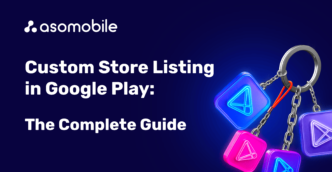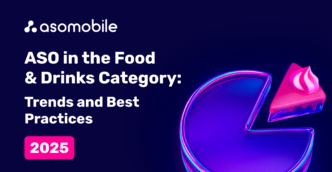App Store Optimization (ASO) in 2022: Mobile App Market Trends
The beginning of the year is the time to take stock and look to the future, what awaits us on the mobile app market, and what ASO optimization trends we can observe based on changes in 2021.
At the end of the article, you can find a 40% discount coupon for the first month of using ASOMobile - a tool for creating ASO and researching competitors in the mobile app market.
Let's start with the most significant events of the past year, which determined the trends of 2022, namely:
- In-app events and their impact on ASO optimization
- A/B tests for iOS applications
- Changes to Google metadata requirements policy
- Video and screenshots in the context of the new requirements of the Google Play Market
- Google Play Security Policy
- Ratings and reviews on the Google Play Market
1. In-app events
There was a lot of news and announcements at the Apple Worldwide Developers Conference 2021 (WWDC 21). This conference is held annually by Apple to help and support partners - application developers. It was at the end of the meeting in 2021 that in-app events in iOS were announced.
In-app events are in-app and game events such as in-game competitions, movie premieres, live streams, and more.

In-app events appear on the App Store as event cards, which include images or videos, the name of the event, and a brief description of the event. Users who do not have the game or app installed can download it directly from the in-app event or from the event details page.
How will in-app events affect ASO optimization?
Now in-app event cards can be found on the App Store - they will be displayed on the application page, in search results, and in the collections of Today, Games, etc.
How will this affect your application? In-app events can now be found directly by searching the App Store, hence increasing the visibility of your app.
A little about the search results.
When users search for a specific event, the event card appears in the search results next to the app.

For users who already have the application installed, in-app events will be displayed in the search results - the event card will simply be displayed in the place of the application. For developers, this is another new opportunity to increase engagement with their current users.
Apple will parse in-app event metadata to show up in search results. Event metadata as a source of App Store trends
- Event title (title) - 30 characters long. Choose a unique and descriptive name for your events. Avoid generic and vague names - a game event or a massive update.
- Brief description (subtitle) - 50 characters long. Will be displayed on the event card and is used to briefly explain the event.
- Full description (description) - will be displayed on the event page, not indexed and limited to 120 characters.
2. A/B testing for iOS applications
This is probably the most long-awaited tool that has been so needed all this time. And it finally got an official launch!
A/B testing allows iOS developers, marketers, and product managers to collect data about app installs based on various product page designs and use this data to improve conversions and make strategic decisions. This user experience optimization process helps developers achieve key business goals such as engagement, retention, and monetization.
- You can create and publish up to 35 custom pages at a time. Each page will be reviewed and must be designed without violations.
- You can customize - screenshots, promo text and preview video for each of the localized pages.
- Once you have created a custom product page, you can use its unique URL. Consequently, your tracking of user behavior will reach a new level - from e-mail newsletters, websites, paying users.
- Ad networks support custom pages. Therefore, it is possible to customize ads using custom pages by specifying a unique CPP ID.
- Based on the previous point, Apple Search Ads supports custom pages and will allow you to use them to create unique and diverse options.
Tips for A/B testing for iOS are the same as general tips for testing the visual elements of an app page.
- test significantly different options and hypotheses;
- the difference in small details does not give an understanding of the picture as a whole and can lead to wrong conclusions;
- testing is possible not only for various elements, but also for their absence (an excellent example would be options for visual elements with or without video);
- the greater the coverage of the audience of users, the more accurate the test results will be;
- remember about the cultural characteristics and the difference in the mentality of different countries. The results for Brazil will differ from Portugal despite the common language environment.
N.B.! Despite the common approach to testing visual elements for the App Store and Google Play, keep in mind that user behavior varies greatly depending on the market. Test platforms separately and do not extrapolate the results of one market to another.
3. Changing the metadata policy on the Google Play Market
In September 2021, the long-announced changes to the App Metadata Requirements Policy and new guidelines for visual elements on the app page in the market came into effect.
Main changes and restrictions:
- Application name - 30 characters, instead of the available 50 (now the same as on the App Store);
- Stricter restrictions for icons - no characters that mislead users. Forget about the TOP 10, the best game, user choice, free and other content on the logo that can misinform users.
- Emoji, repeated elements in the name, icon or developer name will now result in a rejection at the time of the release of the application.
- You can't use information that is irrelevant to your app or game in the metadata. Namely, we are talking about the description, developer name, title, icon, screenshots, promo images, etc.
- The description of the application should be understandable, clear and correct in relation to the functions of the application.
- Anonymous user reviews cannot be used in the description.
- Avoid using words in capital letters, unless it is your brand name, of course.
4. Video and screenshots in the context of the new requirements of the Google Play Market
Video previews are also now subject to stricter rules. Autoplay will now only be 30 seconds of video, so the entire focus of the user's attention will be shifted to them. But you should not get carried away with advertising, the new requirements regulate 80% of the time for the remote user interface, and not for logos and splash screens.
The video cannot include people interacting with the device, unless the interface of the game or app has something to do with the environment, such as an augmented reality game like Pokemon Go or a real-world app like Waze. Preview videos must be submitted in landscape format.
Videos, like metadata, should not contain superlatives or calls to action.
As a result, the video preview is now used to demonstrate part of the gameplay and the application interface, with the above limitations.
5. Google Play Security Policy
Google has significantly changed the security and privacy rules for apps and their users, just like Apple did in the past. The goal is to increase transparency and make it more accessible for users to understand who collects their data and why.
- Developers now need to specify their privacy and security practices right on the app listing page. This way, users will know what data is being collected and why.
- Apps must specify three key points: whether the app complies with Google family policy, whether it uses data encryption, and whether it collects personal and sensitive data.
- All apps, even if they don't collect data, are now required to provide a privacy policy. And developers will have to provide accurate information such as the SDK and data used by the application's third-party libraries. In October, apps will be able to provide this information to Google, and they will have until April 2022 to approve this section. This is important so that apps are not restricted in the store and/or penalized in search results.
- Applications intended for youth audiences are not allowed to use transfer IDs.
- And finally, inactive accounts (1 year or more) for apps with less than 1,000 installs or in-app purchases in the last 90 days will be closed.
What will these changes in Google Play entail?
In ASO specialists, one of the most significant changes to metadata was the shortening of the application name. So far, app developers have been able to use more keywords in their app title on Google Play (50 characters) compared to the App Store (30 characters). This extra space provided more flexibility and a wider experience in the Play Store.
Reducing the indexed metadata field itself to 30 characters affected App Store Optimization:
- There is less room for keywords in the title, forcing developers to select only the most relevant and valuable keywords for their applications.
- The lack of characters will be especially noticeable in languages whose words consist of a large number of letters (for example, French or German).
- Since you can no longer use the words free, best, emoji and other incentive symbols, all application names will become more unified and relevant. You can no longer waste symbols on informational noise.
- All this leads to a more thoughtful approach to keywords, informed decisions and careful checking of search queries that will be used in the application metadata.
6. Reviews and ratings on the Google Play Market
Emphasizing the importance of app ratings and reviews, Google Play Market announced the following changes:
- In November 2021, phone users see ratings related to the country in which they are registered.
- Starting in 2022, users of other form factors such as tablets, Chromebooks, and wearables will begin to see ratings related to the device they are on.
Therefore, the ratings of users in one country will no longer affect the assessment of the application in other regions, since the cumulative ratings of the application do not always correctly reflect the picture as a whole.
An example of app evaluation in the different countries:

Compare app ratings in different countries conveniently using the Rating and Reviews from ASOMobile
The main trends of the mobile application market in 2022
Above, we have described and analyzed in detail the impact of the past year, now let's discuss what trends we will observe and follow in the current year.
2021 showed a stable growth rate of apps and this was facilitated by a global transformation - remote work, home fitness, investments, all in the direct meaning of “in the palm of your hand”. There is no reason to think that competition in 2022 will stabilize or show even a hint of a downturn.
- An increase in the competition for users can lead to a rise in the cost of UA and shift the focus to attracting organic traffic, and as a result, increased attention to ASO app optimization.
- Restricting metadata for Google Play will make competition within the platform better, as it will be harder to manipulate users through exaggeration or misleading than before.
- The economy and management of in-app purchases will come to the fore, especially when it comes to subscriptions, as one of the most popular types of in-app purchases.
- Privacy Trends - Changes since the iOS 15 update have resulted in stricter restrictions on user data. Attribution, ad tracking, and IDFA-based retargeting are becoming less accurate, and app marketers will have to come to terms with the changes.
- The adoption of 5G and what it means for mobile marketing in 2022. New technologies will lead to consumer expectations likely to reach new heights, whether in terms of the quality of digital products, the use of cloud solutions, or the ability to use applications in different countries, on multiple devices.
The speed of change and the dynamics of the market requires great flexibility and plasticity from developers. One of the constant things that require attention, effort, and resources is ASO optimization - as a basis for the development of your application. On average, 65-70% of all app installs come from app store searches. They make up the vast majority of in-store installs, so the practice of increasing your search and view impressions is a key part of your growth.
Don't miss new posts on our blog.
 Українська
Українська  Русский
Русский  Español
Español 






